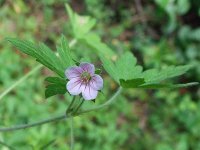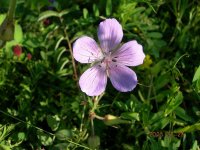Geranium - geranium l.
Botanical characteristics. Perennial herbaceous plant. It grows in meadows, hills, along the banks of rivers and lakes, the outskirts of roads, in thickets of bushes. Some species are the dominant plant of the meadows of the Amur region.
Rhizome thin. Stems are straight or ascending. The leaves are rounded, incised or separated in shape. Flowers are located in pairs in the axils of the leaves, correct. Blossoms from May to June, fruiting about a month after flowering. Fruit is a box. There are several species
The most curative are:
- Geranium Hill - G. Collinum Steph. Stems reach up to 40 cm tall, straight, branched. The leaves are deeply incised into 3-7 lobes. Flowers are pinkish-violet.
- Geranium Siberian - G. sibiricum L. Plant up to 60 cm tall. Stems ascending or straight, elongated-branching. Leaves in diameter are divided into lobed and crenate segments. The flowers are white or purple.
- Geranium Vlasov - G. vlassovianum L. It is the dominant plant of meadows. The leaves are divided almost to the base of the plate. The petals of the flowers are purple-violet. The veins on the leaves are sharply expressed against the background of leaf blades.
All of the above species have curative properties, but the most valuable is geranium hill.
Used parts of the plant. Medicinal raw materials are roots and aerial parts, collected in the usual way. It is better to pull out the plant with a root during the budding period. Dry in bundles in a ventilated room, in the shade.
Chemical composition. The whole plant contains tannins (maximum in the budding phase). The roots of geranium contain phenols (pyragallol, pyrocatechol). In the aerial part there are carbohydrates (sucrose, starch, hemicellulose), phenolic compounds.
Leaves and flowers contain carbohydrates (glucose, sucrose, sorbose, rhamnose, arabinose, xylose, ribose, maltose, starch, hemicellulose), vitamins, phenolcarboxylic acids, their derivatives, ellagatannins, flavonoids (aviculary, guaiarine, isokvetsitrin, rutin, heparin, geranium , Quercetin, kaempferol) and their derivatives, essential oil, pigments.
Application. Preparations of geranium are used in folk medicine as an astringent, with female diseases, dysentery, gastrointestinal diseases, in the treatment of malignant tumors, respiratory infections, lupus, beriberi, rheumatism, insomnia, epilepsy. In Middle Asia, decoction of the roots is used for hemoptysis, as an astringent, hemostatic, blocking. In Tibetan medicine geranium Vlasova is used for pneumonia, for the treatment of eye diseases, eczema. Fresh juice of the plant - with diseases of the ears. You can roll a leaf in the form of a turundock and lay it in your ear for the night. It is very effective infusion of geraniums with deposition of salts of any localization (osteochondrosis, urolithiasis).
In the experiment, the preparations of the leaves of geranium have an inhibitory effect on tumors.
Preparation
- For infusion take 20 g of leaves and flowers, pour boiling water, insist on a water boiling bath for 15 minutes, cool 45 minutes, filter, bring up to 200 ml. Take 2 tbsp. Spoons 2-4 times a day.
- For broth 15 g of roots pour 180 ml of boiling water, insist on a water bath for 30 minutes, cool for 10 minutes, filter, make up to 180 ml. Take should be 1 tbsp. Spoon 3 times a day after meals.
- Fresh juice of flowers and leaves of geranium in a frozen form is used for facial massage, especially for women from 50 years and beyond. Smoothes wrinkles and improves skin color.





Comments
When commenting on, remember that the content and tone of your message can hurt the feelings of real people, show respect and tolerance to your interlocutors even if you do not share their opinion, your behavior in the conditions of freedom of expression and anonymity provided by the Internet, changes Not only virtual, but also the real world. All comments are hidden from the index, spam is controlled.